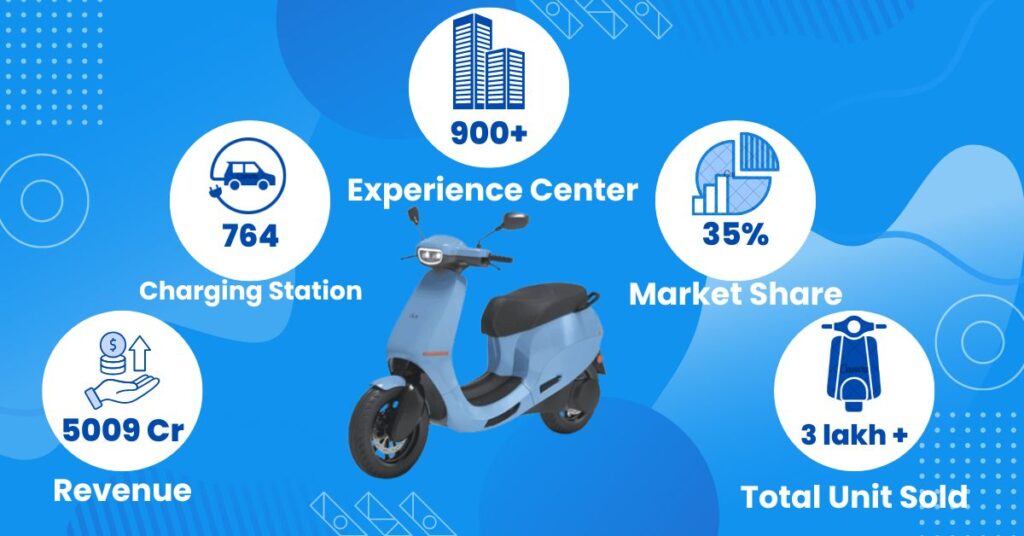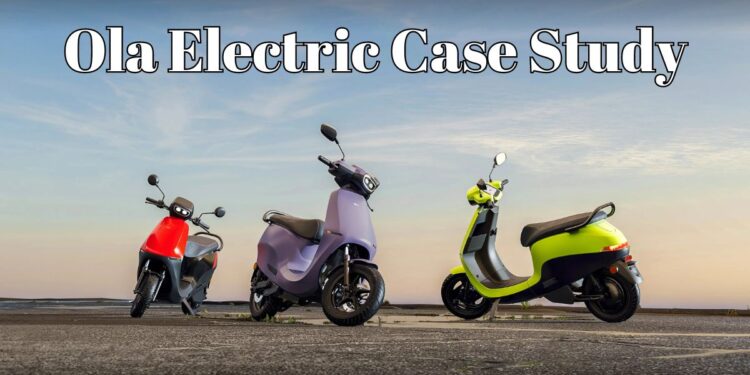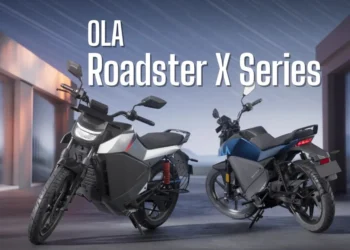As India shifts toward sustainable transportation, Ola Electric stands out as a transformative player in the two-wheeler market, earning the moniker of the “Tesla of India.” This Ola Electric case study delves into the company’s journey, innovative offerings, and strategies for reshaping urban mobility. Whether you’re an EV enthusiast or just curious about electric vehicles (EVs), understanding Ola Electric’s impact on the Indian landscape is essential.
Table of Contents
Background of the Ola Electric
Founded in 2017, Ola Electric emerged with a mission to revolutionize urban mobility in India. Part of the larger Ola ecosystem, the company was established by Bhavish Aggarwal, who envisioned a future where electric vehicles became the norm.
Key Milestones:
- 2017: The establishment of Ola Electric marked the beginning of its journey in the electric vehicle sector.
- 2018-2020: Development phases for the Ola S1 and S1 Pro electric scooters, laying the foundation for their flagship products.
- 2021: Opening the Ola Future Factory, a significant step towards large-scale production, followed by the commencement of S1 Pro deliveries.
- 2022: Launch of a dedicated R&D center focusing on battery innovation, emphasizing the importance of advanced technology in their products.
- September 2022: The first Experience Center opened, enhancing customer interaction and support, with S1 deliveries officially beginning.
- October 2022: Announcement of the S1 Air, along with three additional models set to launch within two years of the first product’s introduction.
- May 2023: The milestone of opening the 500th Experience Center across India, reflects the company’s commitment to customer service and accessibility.
- June 2023: Construction began on a Gigafactory, aimed at scaling production capabilities to meet growing demand.
- August 2023: Launch of the S1 Pro (Gen 2) and three variants of the S1 X/X+, showcasing Ola Electric’s ongoing innovation.
- 2H of 2025: Planned delivery of the Roadster Motorcycles, indicating Ola Electric’s ambition to expand its product range further.
Market Analysis
The Indian electric vehicle (EV) market has witnessed remarkable growth in recent years, fueled by rising environmental concerns and government incentives aimed at promoting sustainable transportation. With the increasing awareness of air pollution and climate change, more consumers are considering electric vehicles as a viable alternative to traditional petrol and diesel options.
Overview of the Indian EV Market
- Current Size: The Indian EV market is valued at approximately $1.5 billion and is projected to reach around $7 billion by 2025.
- Government Initiatives: Policies such as the Faster Adoption and Manufacturing of Electric Vehicles (FAME) scheme and tax incentives have played a significant role in boosting EV adoption.
Growth Trends and Consumer Demand
- Rising Demand: A surge in consumer interest has led to a 200% increase in electric two-wheeler sales in the last fiscal year.
- Shifting Preferences: More urban commuters are opting for electric scooters due to lower running costs and the convenience of home charging.
- Youth Market: A significant portion of the demand is coming from younger consumers, who are more eco-conscious and tech-savvy.
Competition Landscape
The competition in the EV sector is heating up as traditional automakers and new entrants vie for market share.
- Traditional Automakers: Companies like Hero MotoCorp and Bajaj Auto are stepping up their efforts by launching electric models to capture the growing market.
- New Entrants: Startups like Ather Energy and Okinawa are also gaining traction with innovative designs and unique features, catering to a tech-oriented audience.
| Company | Type | Key Models | Market Position |
|---|---|---|---|
| Ola Electric | Startup | Ola S1, Ola S1 Pro | Market Leader in EVs |
| Ather Energy | Startup | Ather 450X | Strong Urban Appeal |
| Hero MotoCorp | Traditional OEM | Hero Electric Scooter | Established Brand |
| Bajaj Auto | Traditional OEM | Chetak Electric | Focus on Retro Design |
| Okinawa | Startup | Praise Pro | Aggressive Pricing |
Unique Value Proposition of Ola Electric

Ola Electric distinguishes itself through innovative features and a strong commitment to sustainability.
Innovative Features
- Smart Connectivity: Real-time information through the Ola app.
- Performance: Acceleration from 0 to 40 km/h in just 3.6 seconds.
- Customizable Riding Modes: Eco, Normal, and Sport modes.
Key Differentiators
- Direct Sales Model: Selling online reduces costs and improves customer engagement.
- Unique Design: Modern aesthetics that appeal to younger audiences.
- Enhanced Charging Infrastructure: Comprehensive network of charging stations.
Business Model
Ola Electric’s business model is designed to maximize growth and customer satisfaction while adapting to the evolving demands of the electric vehicle market. It focuses on multiple revenue streams, strategic partnerships, and a direct-to-consumer approach, setting it apart from traditional automakers.
Ola Electric’s business model focuses on multiple revenue streams and a direct-to-consumer approach.
Revenue Streams
- Sales Revenue: Direct sales of electric scooters.
- Subscriptions: Monthly battery leasing plans.
- Service and Maintenance: Revenue through maintenance packages.
Partnerships
- Collaborations with local governments for charging infrastructure.
- Tech partnerships for software improvements.
Technology and Innovation
Ola Electric is at the forefront of technological advancements in the electric two-wheeler market, leveraging a range of innovative solutions to enhance performance, safety, and user experience. The company invests significantly in research and development to stay ahead in this rapidly evolving sector.
Key Technologies
- Battery Technology: High-capacity lithium-ion batteries.
- Smart Software: Integration with the Ola app for data insights.
- Safety Features: Advanced braking systems and stability control.
R&D Efforts
- Continuous improvements in battery efficiency.
- Exploration of autonomous driving capabilities.
Marketing and Branding Strategies
Ola Electric has crafted a compelling marketing and branding strategy that resonates with its target audience while positioning itself as a leader in the electric two-wheeler market. By leveraging innovative campaigns and engaging with the community, the company effectively communicates its values and mission.
Target Audience and Positioning in the Market
Ola Electric primarily targets urban commuters, particularly younger consumers who are environmentally conscious and tech-savvy. The brand positions itself as a forward-thinking alternative to traditional scooters, emphasizing sustainability, innovation, and modern design.
Key Marketing Campaigns and Strategies
Ola Electric has implemented several impactful marketing campaigns:
- Launch Campaigns: The launch of the Ola S1 and S1 Pro was accompanied by high-energy promotional events that highlighted features through live demonstrations and influencer endorsements.
- Awareness Campaigns: Educational initiatives aimed at informing consumers about the benefits of electric mobility have been key. These campaigns focus on environmental impact, cost savings, and technological advancements.
- Promotional Offers: Seasonal discounts and financing options make the scooters more appealing to price-sensitive customers, encouraging trial and adoption.
- Ola HyperService Campaign: To enhance after-sales support, Ola Electric has launched the Ola HyperService campaign. With plans to double its service network to 1,000 centers by December 2024, this initiative addresses rising service concerns and significantly improves the overall ownership experience.
Financial Performance
Ola Electric’s financial performance reflects its ambitious growth trajectory and commitment to becoming a leader in the electric mobility market. Through various funding rounds and strategic investor partnerships, the company has secured substantial resources to support its expansion plans.
Funding Rounds and Investors
Ola Electric has completed a series of funding rounds to fuel its operations and growth:
- Total Funding Rounds: 14
- 1 Seed Round
- 4 Early-Stage Rounds
- 5 Late-Stage Rounds
- 4 Debt Rounds
- Total Funding Amount: $1 billion
- Largest Funding Round: $267 million
- Total Investors: 57
- 37 Institutional Investors
- 20 Angel Investors
This diverse funding mix has allowed Ola Electric to leverage both institutional backing and insights from experienced individual investors.
Challenges Faced
As Ola Electric has rapidly expanded in the electric mobility market, it has encountered several key challenges that have tested its resilience and adaptability. Addressing these challenges is crucial for sustaining growth and maintaining its competitive edge.
Key Challenges During Growth and Scaling
- Supply Chain Disruptions
- The global supply chain has been volatile, affecting the availability of crucial components like batteries and electronic parts. Ola Electric faced delays in production timelines and had to adjust its supply chain strategy, including sourcing from multiple suppliers to mitigate risks.
- Market Competition
- The entry of numerous competitors in the electric vehicle sector has intensified the battle for market share. Established brands and new startups alike have ramped up their offerings, prompting Ola Electric to continuously innovate and improve its product features and customer service.
- Infrastructure Development
- While Ola Electric has made strides in building a charging network, the overall charging infrastructure in India remains underdeveloped. This limitation can deter potential customers who may be hesitant to switch to electric vehicles due to concerns about charging availability.
- Customer Education and Adoption
- A significant portion of the Indian population is still unfamiliar with electric vehicles. Educating consumers about the benefits and functionalities of electric scooters has been essential. Ola Electric has invested in marketing and outreach initiatives to raise awareness and encourage adoption.
- Scaling Operations
- Rapid growth requires scaling operations efficiently without compromising quality. Ensuring that manufacturing processes can meet increasing demand while maintaining high standards has been a challenge for the company.
- Regulatory Compliance
- As the EV market evolves, so do regulations and standards. Keeping up with changing policies, subsidies, and safety regulations can be a complex task that requires ongoing attention and adaptation.
Future Outlook
Ola Electric is poised for significant growth in the coming years, driven by ambitious expansion plans and a strong commitment to innovation. As the electric vehicle (EV) market in India continues to evolve, the company is strategically positioning itself to capitalize on emerging opportunities.
Expansion Plans
- New Markets: Ola Electric is exploring entry into international markets, particularly in regions with growing demand for electric mobility. This includes potential expansion into Southeast Asia and Europe, where regulatory support for EVs is increasing.
- Product Lines: The company plans to diversify its product offerings beyond two-wheelers. Recently, Ola has launched three motorcycles in the Roadster series: the Roadster X, Roadster, and Roadster Pro. Each model features distinct specifications in terms of battery capacity, motor power, range, and additional features tailored to different segments of riders. This expansion into motorcycles demonstrates Ola’s commitment to capturing a broader market and catering to varying consumer preferences.
- Service Network Growth: With the launch of the Ola HyperService campaign, Ola Electric aims to double its service centers to 1,000 by the end of 2024. This expansion will enhance customer support and strengthen the overall ownership experience.
Role of Technology and Innovation in Shaping the Future
Ongoing investments in technology and sustainability will continue to shape Ola Electric’s trajectory.
- Continuous Innovation
- User Experience Enhancements
- Sustainability Initiatives
Conclusion
The Ola Electric case study illustrates how this company is not just selling scooters but also shaping the future of transportation in India. With innovative products and a commitment to sustainability, Ola Electric is well-positioned to lead the charge in the electric two-wheeler market, paving the way for a cleaner and more efficient tomorrow.







